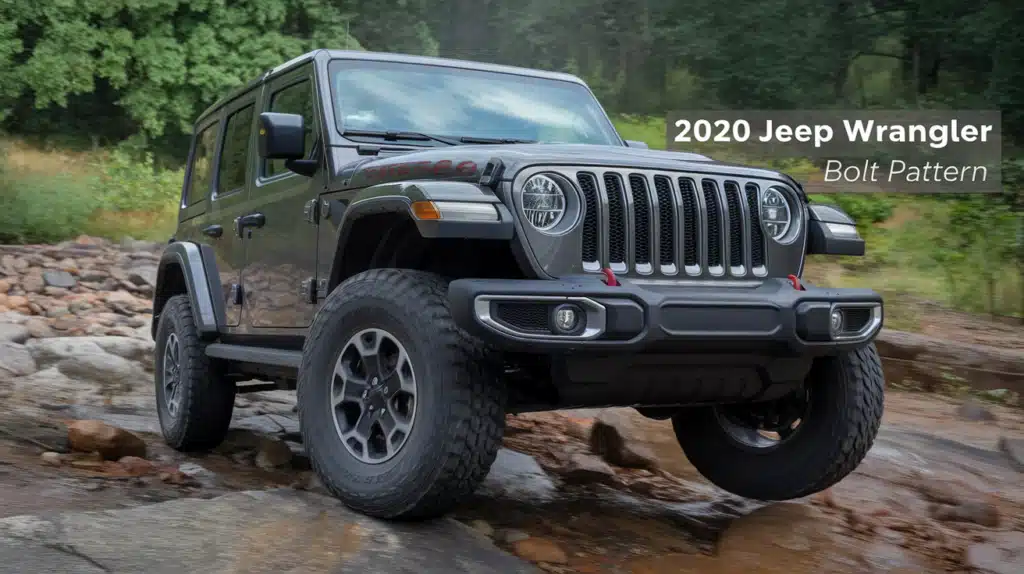The Jeep Wrangler has long been an icon in the off-road community, celebrated for its rugged durability and exceptional capability on challenging terrain.
Whether tackling rocky trails or cruising city streets, one critical aspect of maintaining your Jeep’s performance and safety is understanding its wheel bolt pattern configuration.
This often-overlooked detail is vital in proper wheel fitment and vehicle stability.
From the classic CJ series to the modern JL Wrangler, each model has specific bolt pattern requirements that owners must understand to ensure optimal performance.
Incorrect bolt patterns can lead to serious safety issues, compromised handling, and potential damage to your vehicle’s wheel hub assembly.
This guide will help you recognize the essentials of Jeep bolt patterns and their maintenance.
Jeep Wrangler’s Bolt Pattern
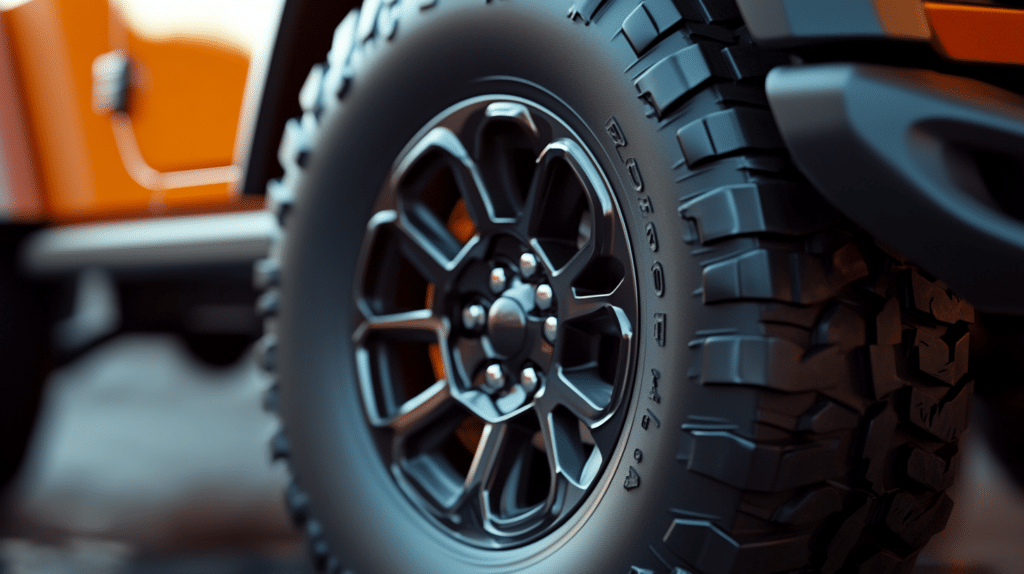
Jeep Wranglers have used different bolt patterns throughout their generations, with most models featuring a 5-lug configuration.
The current JL Wrangler (2018-present) and JK Wrangler (2007-2018) use a 5×5 bolt pattern, meaning they have 5 lugs spaced in a circle with a 5-inch diameter.
Earlier models like the TJ (1997-2006) and YJ (1987-1995) Wranglers came with a 5×4.5 bolt pattern. This difference in bolt patterns is crucial when selecting wheels, as they must match your specific Wrangler model year.
To measure a 5-lug bolt pattern on any Wrangler, measure from the center of one lug hole to the back edge of the hole farthest away (skipping one hole).
This will give you the bolt circle diameter measurement for proper wheel fitment.
Bolt Pattern Compatibility
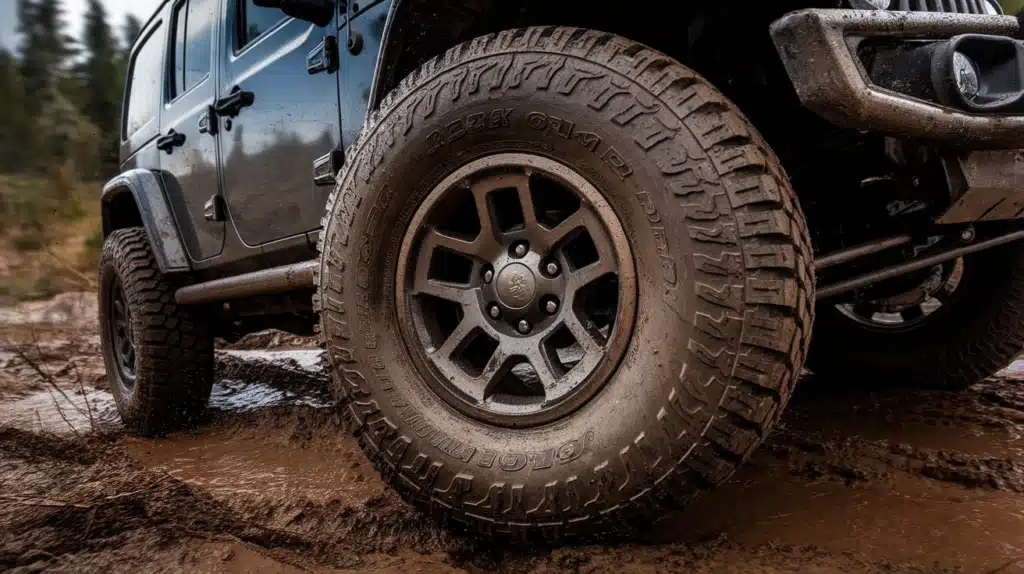
The bolt pattern is critical to determining wheel compatibility for your Jeep Wrangler.
It refers to the diameter of the imaginary circle formed by the wheel’s lug holes, directly impacting which aftermarket wheels will fit your vehicle.
For example, wheels designed for a JK Wrangler with its 5×5 pattern won’t fit on a TJ Wrangler’s 5×4.5 pattern, even though both have five lugs.
This standardization helps ensure proper wheel mounting and vehicle safety. When planning tire and wheel upgrades, the bolt pattern is your first compatibility checkpoint – even if a wheel’s diameter and width match your desired specifications, an incorrect bolt pattern makes it impossible to mount the wheel properly.
Wheel adapters or spacers can sometimes overcome bolt pattern differences, but choosing wheels that naturally match your Wrangler’s bolt pattern is generally recommended.
Bolt Patterns by Model

The Jeep Wrangler’s bolt pattern has evolved across different generations, creating distinct compatibility groups for wheel fitment:
JL (2018-present) and JK (2007-2018):
-
- Both share the 5×5 bolt pattern
- Fully interchangeable wheel compatibility between these generations
- Most modern aftermarket wheels are designed for this pattern
TJ (1997-2006) and YJ (1987-1995):
-
- Both utilize the 5×4.5 bolt pattern
- Share wheel compatibility with each other
- Extensive aftermarket wheel options are still available
- Cannot directly mount JK/JL wheels without adapters
Key Differences:
-
- JK/JL wheels won’t fit TJ/YJ models without adapters due to the 0.5-inch difference in bolt circle diameter.
- Aftermarket manufacturers often provide separate wheel lines for these two distinct bolt patterns.
- Modern wheel designs typically favor the newer 5×5 pattern due to the popularity of JK/JL models.
Identifying The Bolt Patterns

Accurately measuring your Jeep’s bolt pattern is essential for proper wheel fitment. To measure a 5-lug pattern, which is most common across Jeep models, align your ruler from the outer edge of one hole to the center of the hole two positions away (skipping one hole).
This measurement represents the bolt circle diameter. For 6-lug patterns, typically found on 1974-1991 J Series and Full Size Wagoneers, measure from center to center of holes directly across each other.
Essential tools include a tape measure or ruler with clear markings. Common mistakes to avoid include measuring to the wrong hole position on 5-lug patterns and forgetting to measure from the outer edge of the first hole.
Always double-check measurements against your Jeep’s specific model year specifications to ensure compatibility.
Comparing Bolt Patterns
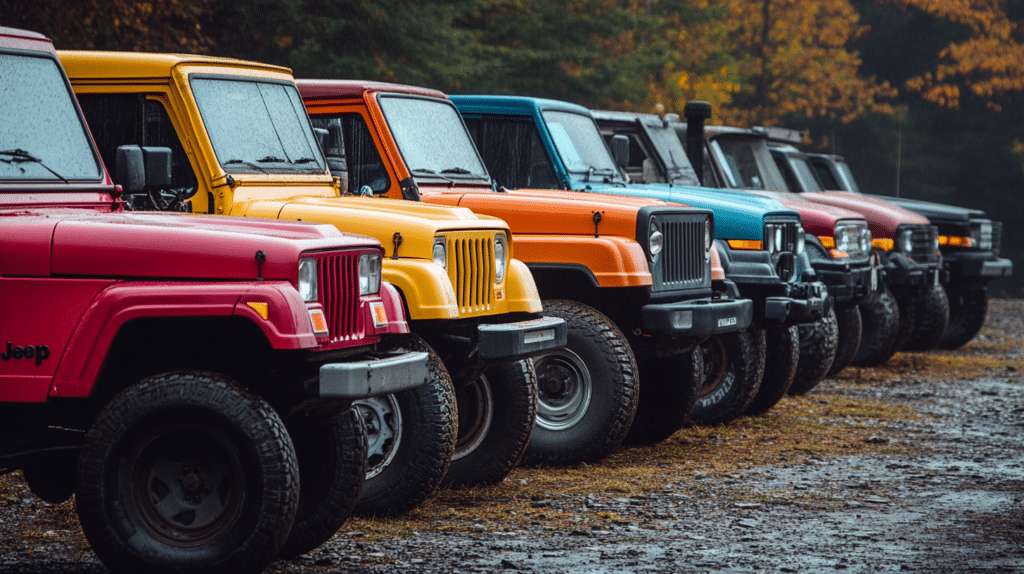
Most Jeep models utilize either a 5×4.5 or 5×5 bolt pattern, making them compatible with a wide range of aftermarket wheels.
The 5×5 pattern, found on JK/JL Wranglers (2007-present) and newer Grand Cherokees, aligns with many popular off-road vehicles like the Ford Bronco and certain RAM trucks, offering extensive wheel options.
Earlier Wranglers (YJ/TJ) share the 5×4.5 pattern with many Ford and Toyota SUVs, providing additional wheel choices.
Regarding pricing, wheels compatible with Jeep’s common bolt patterns typically range from $150-400 per wheel, comparable to competitor fitments.
However, vintage Jeep models like the CJ series use a unique 5×5.5” pattern, which can limit wheel options and potentially increase costs due to more specialized manufacturing.
Choosing Wheels and Tires
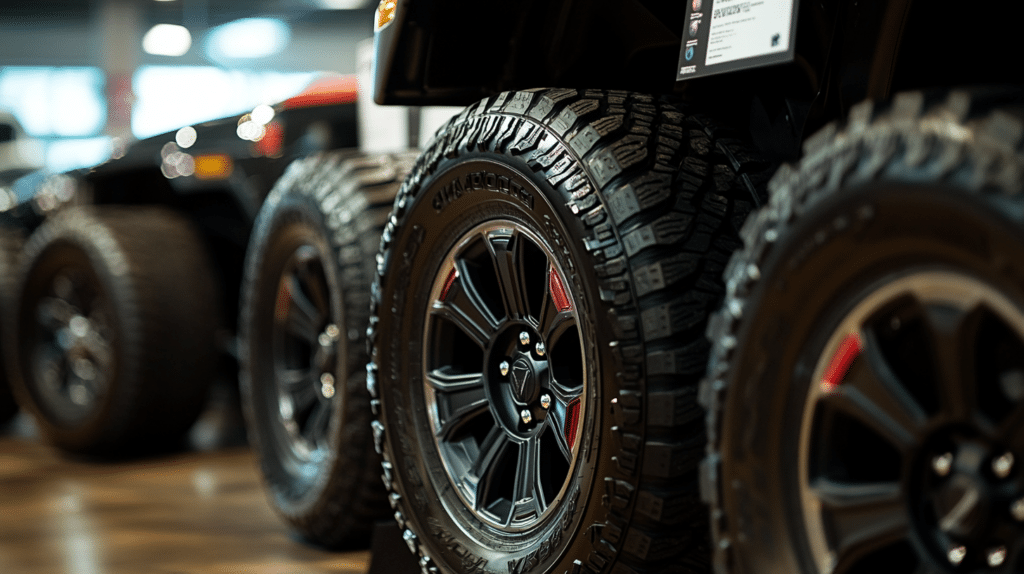
When selecting wheels for your Jeep, several critical factors beyond the bolt pattern require careful consideration.
Wheel Specifications:
- Offset: Lower offset (like JK Wrangler’s common +44mm) provides better clearance for larger tires
- Backspacing: Typically 4.5 to 6, depending on tire size and lift
- Hub-centric vs. Lug-centric: Hub-centric offers better weight distribution and reduced vibration
Material Comparison:
- Alloy wheels: 8-10 pounds lighter than steel, better heat dissipation
- Steel wheels: More durable for extreme off-roading, typically cheaper
Tire Selection Based on Use:
- Off-road: 33″-37″ diameter with aggressive tread patterns (e.g., BF Goodrich KO2)
- All-terrain: 31″-33″ offering balanced on/off-road performance
- Highway: Standard size (29″-31“), focusing on comfort and fuel efficiency while maintaining OEM specifications
Consider vehicle lift, fender clearance, and intended use when pairing wheels with tires. Proper fitment ensures optimal performance and prevents rubbing issues.
Maintaining Bolt Patterns
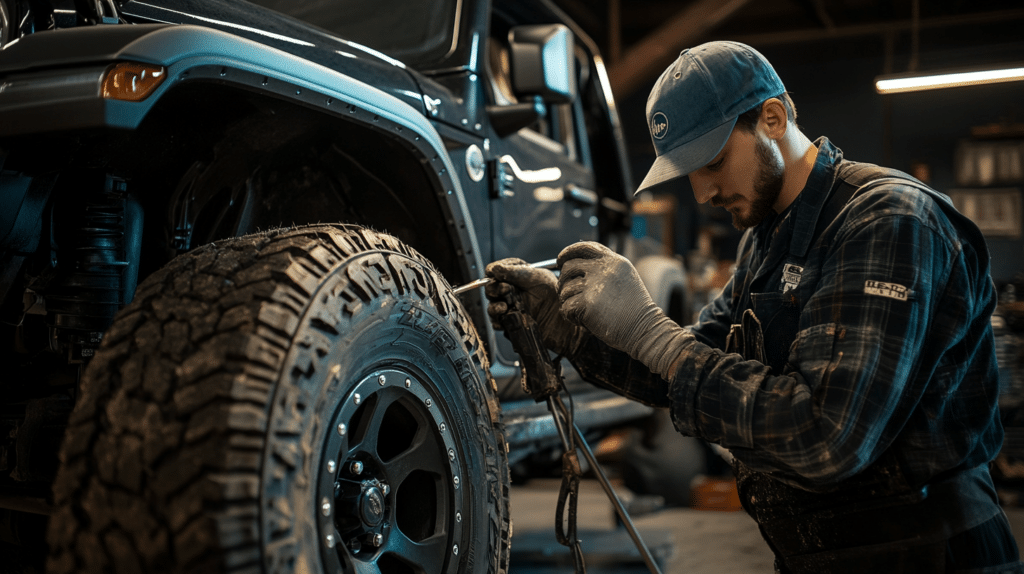
Maintaining your Jeep’s wheel bolt patterns and lug nuts is crucial for vehicle safety and performance.
Perform periodic inspections to check for any signs of wear, rust, or damage to the lug nuts and the bolt holes.
Clean the mounting surfaces and threads regularly to prevent corrosion and ensure proper torque application.
Inspect the hub center bore and lug studs for any deformation or damage when removing wheels.
Remember to follow the manufacturer’s torque specifications when reinstalling wheels – for example, 1/2” lug nuts typically require 75-85 ft/lbs of torque.
After installing the wheels, recheck the torque after 20-30 miles and again after 100 miles to ensure everything remains properly secured.
This maintenance routine helps prevent wheel-related issues and extends the life of your bolt pattern components.
Common Bolt Pattern Issues
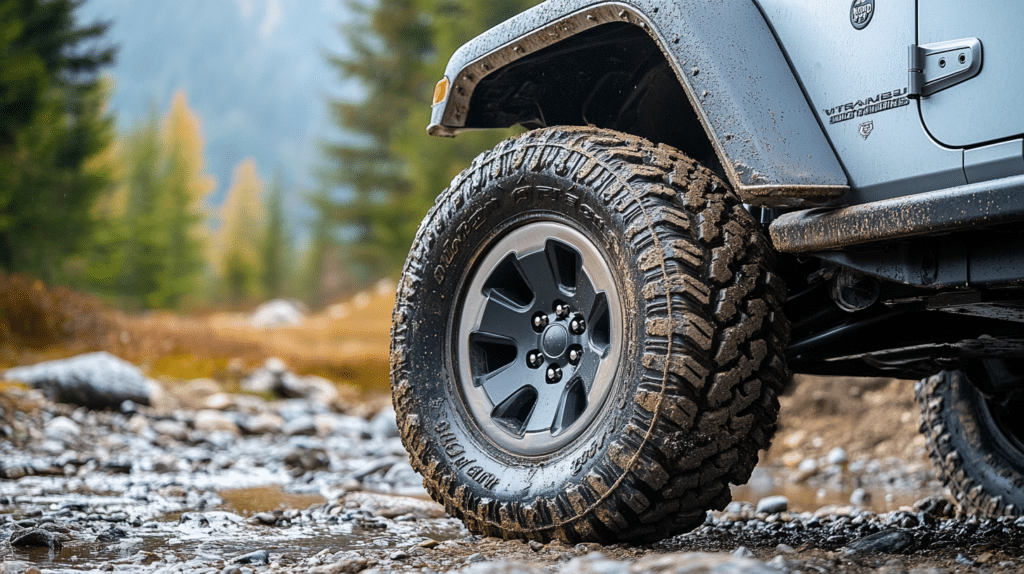
When dealing with Jeep wheel bolt patterns, several common issues can arise that every owner should be aware of.
Over-torquing lug nuts is one of the most frequent problems, leading to stretched or broken studs and compromised wheel security.
Under-torquing is equally dangerous, potentially causing wheels to become loose during operation. Misalignment often occurs when dirt or rust builds up on the mounting surface, preventing the wheel from sitting flush against the hub.
Cross-threading lug nuts during installation can damage the nut and stud threads, requiring complete replacement.
DIY fixes, properly clean mounting surfaces and threads before installation, and always use a torque wrench to achieve correct specifications.
However, if you notice stripped threads, damaged studs, or excessive runout (wobble), it’s time to consult a professional mechanic.
Never attempt to repair stripped or damaged lug studs yourself, as this could compromise vehicle safety.
Conclusion
Knowing your Jeep Wrangler’s bolt pattern helps keep your trips safe and fun.
Each Jeep generation needs specific wheel measurements to work correctly, from the older CJ models with their 5×5.5 pattern to today’s JL and JK Wranglers with 5×5 setups.
Good maintenance makes a big difference! Check your lug nuts often, use the right torque settings (check again after 20-30 miles and once more after 100 miles), and keep all mounting areas clean and rust-free.
For daily drives or tough trail rides, taking care of your Jeep’s bolt pattern helps it stay strong and reliable.
If anything seems unclear, the owner’s manual has helpful information, and local mechanics are always ready to help keep your Jeep rolling safely down any path you choose.


